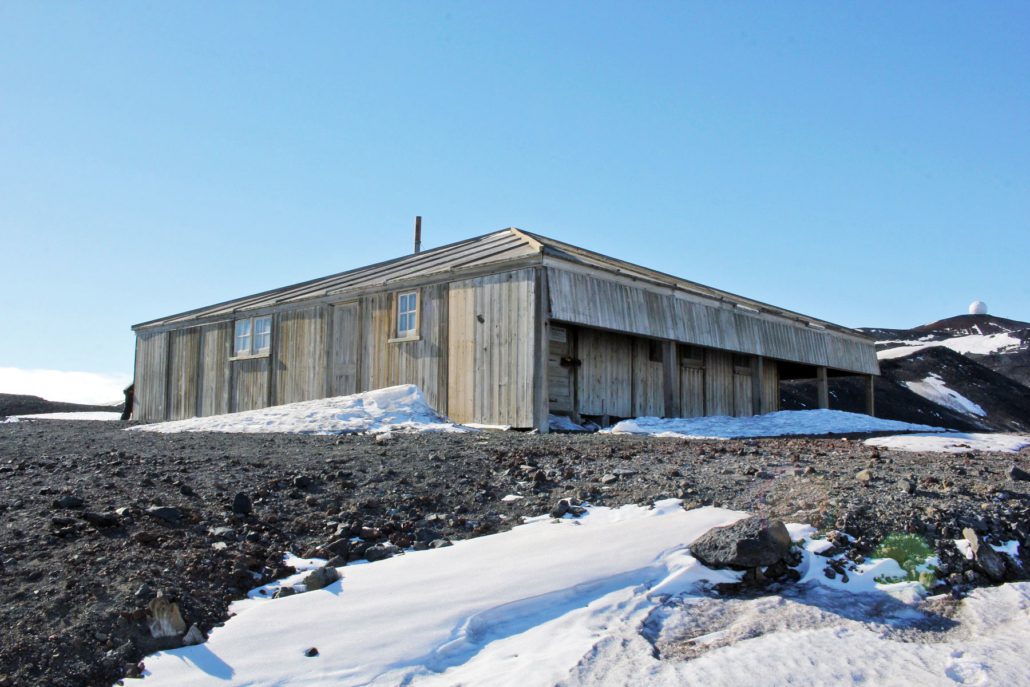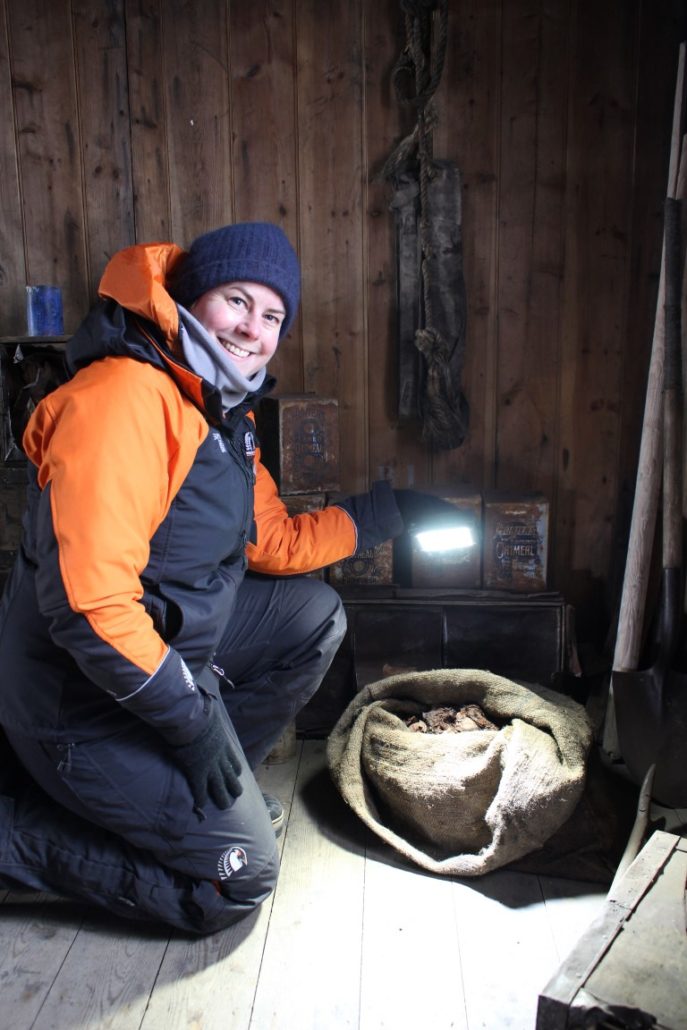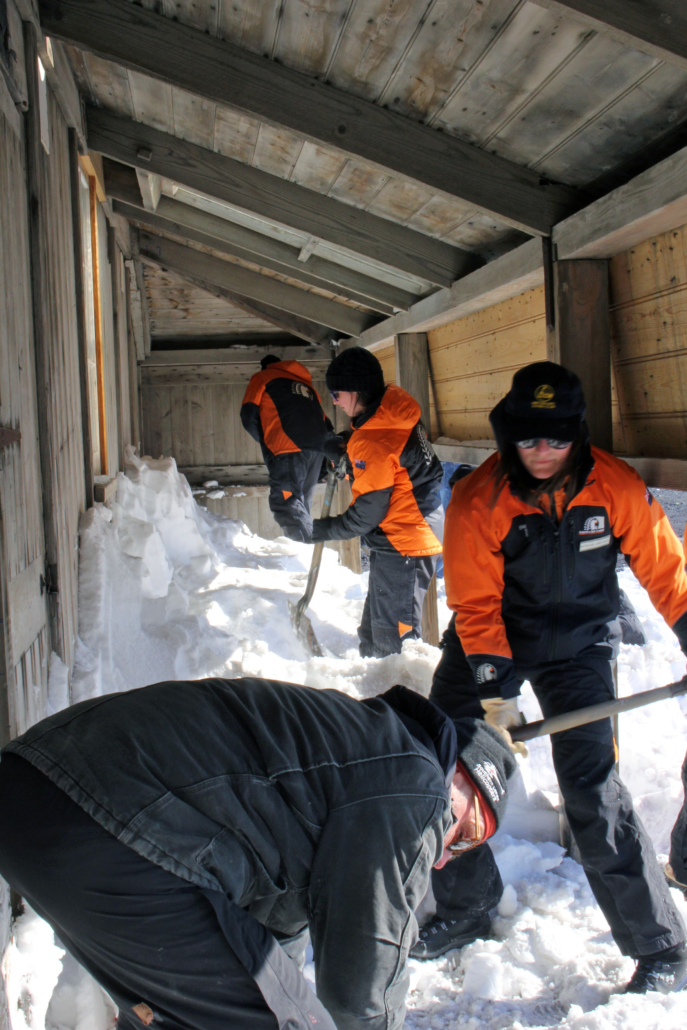Joining the Conservation Team
by Francesca Eathorne
Blog number four from the Trust’s General Manager Operations and Communications on her first experience of Antarctica.
For Francesca’s previous posts, please see the Antarctic Blog feed.
Now that I have completed AFT (Antarctic Field Training – read that blog here) I can officially head out with Al and Nicola on the conservation team to assist with this season’s monitoring and maintenance programme.
Each season the conservation team inspect the huts and their artefact collections to ensure the buildings remain weathertight and the conservation treatments of the artefacts are holding up in the challenging environment. Alongside some manual tasks like digging out snow at the huts, there are various measurements taken and the artefacts are checked and photographed.
 Antarctic Heritage Trust/Nicola Stewart
Antarctic Heritage Trust/Nicola Stewart Discovery Hut.
After lunch we plan to head out to Scott’s Discovery Hut. It’s a mild day in Antarctica at only -11 degrees, which is considerably warmer than the previous few days that were hitting around -20 with a hostile wind blowing.
I’ll be assisting Al and Nicola with the various tasks. I’m excited to see the conservation work first-hand. We pack our bags, including our ECW (extreme cold weather) gear as it’s a requirement for us to carry this with us when we travel outside of Scott Base—a good reminder that the conditions can and do change frequently. I put all nine pairs of gloves in my bag as I’m still working out which combinations I like best. I also throw in my She-wee and pee bottle as these are also essentials when venturing off base.
It takes quite a while to pack up everything we need, which includes shovels, a rake, vacuum cleaner, various tools for minor repairs, photography gear, lights and monitoring equipment. Everything is piled into one of the Toyota Landcruisers that you can book to drive off base. After the truck spends half an hour warming up, we are off to Discovery Hut.
Scott’s National Antarctic Discovery Expedition (1901-1904) chose Winter Quarters Bay, located in McMurdo Sound, a small indentation at the end of Hut Point Peninsula on Ross Island, as the site to winter over. Scott’s original idea was to send a small winter party to stay in the hut but he changed his mind and the ship, which was secured to an icefoot in the bay, became home to all 47 expedition members.
I’d visited the hut briefly a few days earlier and I’m keen to get back and have a closer look around. Nicola tells me on the way over that the coldest she has ever felt was while working at Discovery Hut during winter as the wind can whip around Hut Point and curl over the top making working outside almost impossible at times. Luckily today the wind is mild and the temperature feels moderate (am I acclimatising already?).
Our first task is to set up the photography table and lights so Nicola can inspect and photograph various artefacts. The idea is that they can be compared season to season and any signs of deterioration can be quickly spotted and addressed. I’m pleased I can help Nicola out by holding the lights in a useful place as she moves around the huts photographing some items in situ. I’m amazed to find a sack of red onions in one corner of the hut. It’s a partially full bag and the pinkish tinge clearly identifies them as red onions. It’s just incredible to think they have been sitting there for well over a century. Nicola carefully inspects the onions to ensure there are no signs of mould. All is good.
 Antarctic Heritage Trust
Antarctic Heritage Trust Francesca with a bag of onions that’s at least 100-years-old.
In the meantime, Al has been completing his exterior inspection of the hut and is completing a few minor maintenance tasks. I head up to Vince’s Cross to meet Al. The cross is about 100 metres south-west of the hut and is a memorial to George Vince who sadly died early on the Discovery expedition while attempting to return to the ship during a storm—a poignant reminder of how treacherous this seemingly benign headland is. The wind is slicing across the top of the rocky point and my fingers are freezing within 60 seconds of me removing my outer layer of gloves so I can take some photographs. Down on the sea ice below there are seals with their pups lolling about. When the sea ice has broken out it’s common to see whales spyhopping here. The Hut Point peninsula shoreline is eroding badly, mostly due to the sea ice breaking out early and there being more wave action that is slowly ebbing the land away. One day it will affect Vince’s Cross so the plan is to monitor the erosion closely so that plans can be make to ensure the cross’s safety.
The wind is picking up and I can see why Nicola had her most freezing day at this site. I walk back to the hut and my eyeballs feel like they are freezing solid. I’ll have to swap my sunglasses for my goggles to stop the wind cutting into the side of my face so much. Despite my hands being quickly put back in my gloves (two pairs of them) my fingers are numb. It will be a good ten minutes before they thaw out.
Once I get back to the hut Nicola asks me to complete the annual task of sweeping out the floor of the hut. We decide to do this by hand first. Nicola shows me the scoria that accumulates from visitors’ boots that needs to be cleaned up. It’s not to be confused with the ‘historic’ dust and sediment that has gathered along the walls, between artefacts and in dark corners. This is to be left to add to the atmosphere of the hut. I wear a head torch so I can spot the difference!
Kneeling on the floor seems to be the best way to slowly move around, sweeping gently with my brush and pan. There is a surprising amount of scoria rock around and I sometimes reach into the recesses to pick the little grey stones out. I wish I had remembered to bring my knee pads—now I know why they are in my kit. It’s a good task to keep warm though and I enjoy moving around each space as it gives me a close up look at the artefacts and architecture from a unique perspective.
After a while I decide I need to use my She-wee. One piece of advice I have heard from a number of people is that when you think you need to go, go then. Don’t wait or it suddenly becomes an urgent task; and nothing happens quickly in Antarctica. I ask Al where I’m best to position myself as it’s not within the code of conduct to toilet inside the hut. He advises somewhere out of the wind and away from the various visiting Americans wandering around the site.
I’m feeling confident to use my She-wee and decide that just outside the front door will be the most private spot. I get the She-wee and my pee bottle and sort myself out. I leave one pair of gloves on and work on positioning the She-wee around three layers of pants. It’s a bit of a logistical exercise but I’m thinking it’s good practice ahead of my upcoming camping trip to Cape Evans.
The wind is really howling now and my hands go numb quickly, which makes holding the She-wee and pee bottle simultaneously quite tricky. I really hope no visitors suddenly pop around the corner or they are in for a shock. Then my body just shuts down. It’s no go. Too cold, thanks very much my bladder says. I wait a bit longer willingly myself to just relax but it’s no good.
Al kindly says he will run me down to Mac Town (McMurdo Station), which is just down the road. It’s nice to have a quick break and warm up ahead of the final part of the work programme.
Next up I’m assisting Al with collecting measurements for the hut’s monitoring programme. This is done at strategic points around the hut with Al up a ladder taking readings from the wood to test the hut’s moisture levels. The temperature in the hut is -7 degrees. Somehow knowing this makes me feel cold all of a sudden. It’s more likely that I’ve gotten cold because I haven’t been moving around so much.
Two staff from Antarctica New Zealand pop over to clear the data loggers, which measure temperature and relative humidly. This information helps to establish baseline data and to help the design team understand how the hut’s microclimate is responding to the initial conservation work. Al is pleased the hut is dry and the readings reinforce this. There has only been a little bit of snow ingress this year; again, Al is pleased as the snow mitigation measures put in place last season have been successful.
 Antarctic Heritage Trust
Antarctic Heritage Trust Volunteers from Scott Base working to clear snow from the exterior of Discovery Hut.
We are all quite cold now and I’m glad it’s not just me feeling the cold seep into my bones. Apparently, Discovery Hut is always a tough site to work at.
I imagine the men of Scott’s Discovery expedition realising that sleeping in the hut was not going to be possible as it is too cold, and the subsequent parties who used the hut as a staging post (both Scott’s Terra Nova expedition and Shackleton’s Ross Sea Party) and the hardships they endured. Discovery Hut is often described as dark and depressing compared with the other heroic-era huts.
I don’t have anything to compare it to yet but there’s something about it that I really like. Perhaps it’s the sense of hope and possibility the men had about the adventures that lay ahead when they first landed. Before they felt the wind cut through them day after day, before the adversity began.
The men called the hut the Royal Terror Theatre and used it to stage various musicals and plays of the time to entertain each other. I like this perspective on the hut as it conjures up images of camaraderie and laughter amongst the bleak Antarctic landscape.
We pack up quickly and, heads down, battle the wind back to the Toyota. Upon reaching Scott Base we head to the Tatty Flag bar to warm up with a whisky. A few other people join us and soon stories are flying across the bar. I smile to myself as I think about how over 100 years on that same sense of friendship and teamwork is in full force just over the hill at New Zealand’s Scott Base.

